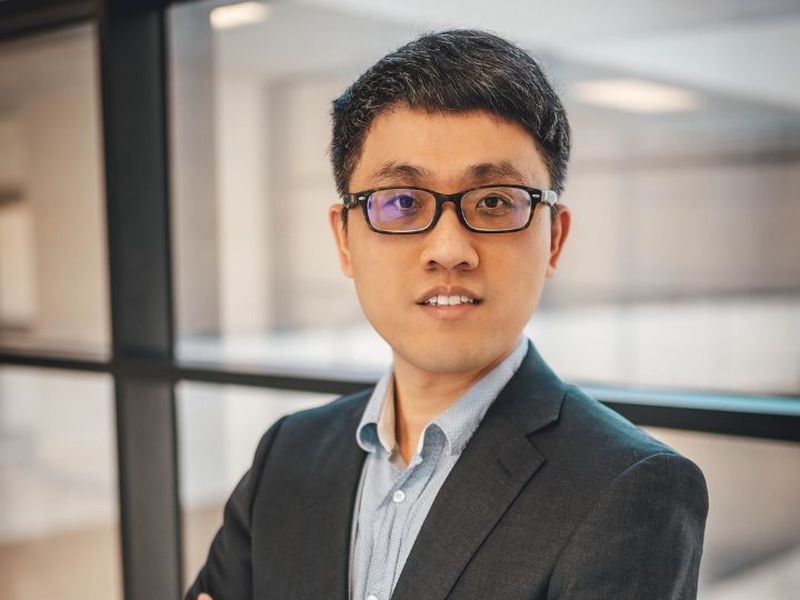In the race to achieve a net-zero future based on clean energy, renewable energy sources like solar and wind power have emerged as potential champions in the battle against climate change. However, as traditional synchronous generators are replaced by inverter-based renewable energy resources, the transition creates a low-inertia challenge within the existing power grids leading to stability and reliability concerns.
Xingpeng Li, assistant professor of electrical and computer engineering at the University of Houston, is working on a solution that will allow seamless integration of renewable energy sources with the rest of the power grid without causing any problems. He received a National Science Foundation CAREER Award for his proposal “Frequency-Constrained Energy Scheduling for Renewable-Dominated Low-Inertia Power Systems.” The goal of the project is to ensure that evolving power systems can continue to operate efficiently and stably while supporting fast-growing wind and solar generation.
Inertia is the total kinetic energy stored in the heavy rotating synchronous generators, which is necessary for ensuring system stability including frequency stability during large disturbances.
“For example, when the grid experiences sudden large generation losses or increased electrical loads, the stored kinetic energy immediately converted to electrical energy and addressed the temporary shortfall in generation,” Li explained.
“However, as the proportion of wind and solar power increases in the grid, we want to maximize their use since their marginal costs are zero and they provide clean energy,” he added. “Since we reduce the use of those traditional generators, we also reduce the power system inertia substantially.”
Li and his research team will use machine learning to create more efficient and less complicated dynamic performance models and then integrate these models into the day-ahead scheduling application used by grid operators to schedule all the generating resources for the next operating day.
“By merging the machine learning model with the optimization model for scheduling in this new framework, we can not only ensure efficient operations, but also ensure grid stability,” he said. “With the proposed new modeling and computational approaches, we can better manage grid and ensure it can supply continuous quality power to all the consumers.”
Li also wants to inspire and engage future generations – specifically K-12 and college students, including those in graduate programs.
His team will also create a free open-source tool for the larger research community to provide benchmarking capabilities. It will have an easy-to-understand graphical user interface to explain power engineering to K-12 students and encourage them to consider power industry careers down the road.
Additionally, the researchers are developing a new course called “Applied Machine Learning in Power Systems,” or “AppML” for short, to help teach advanced concepts.
“Machine learning technologies are becoming much more popular in power systems as they help improve various power system applications. As the demand for machine learning expertise grows, it is essential for students and engineers to gain knowledge and skills in ML,” Li said. “However, there are not many courses nationwide that combine ML and power systems. This new course will address this workforce need.”
Earlier this year, the National Academies of Sciences, Engineering and Medicine’s Gulf Research Program selected Li as an Early-Career Research Fellow in the Offshore Energy Safety Track. The early-career award is not attached to a specific project, which allows fellows to take on research they might not otherwise be able to pursue.
Li’s research interests include planning and operations of various power energy systems including bulk power grids and microgrids. He leads the Renewable Power Grid (RPG) Lab at UH. He is also the Associate Director of the Power Electronics, Microgrids & Subsea Electrical Systems Center (PEMSEC) at UH.
His lab focuses on energy security, transition and transmission for both onshore and offshore energy systems. With a goal to promote renewable energy-enriched future power grids, the group proposes new models and algorithms to improve the efficiency and security of energy systems. The lab’s work also contributes to net-zero energy systems by facilitating grid integration of renewables and green hydrogen.
Li has authored over 60 peer-reviewed papers and has been rapidly expanding his research over recent years. In 2019, he received Tier-1 and Tier-2 Silver awards from the U.S. Department of Energy’s Office of Electricity for two winning submissions to the Electricity Industry Technology and Practices Innovation Challenge prize competition. He was named an Emerging Leader by the Offshore Technology Conference and selected by the Georgia Tech Energy Faculty Fellows program in 2023.
Prior to joining UH, he was a senior application engineer at ABB’s Power Grid division that is now Hitachi Energy. He also worked with the R&D divisions of ISO New England and PJM Interconnection.
Li has a bachelor’s degree in electrical engineering with a focus on power engineering from Shandong University and a master’s degree in electrical engineering focusing on power systems from Zhejiang University, both in China. He earned a second master’s degree in industrial engineering from Arizona State University and a third one in Computer Science (machine learning) from Georgia Institute of Technology and a Ph.D. in electrical engineering from Arizona State University.
